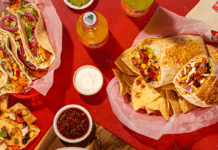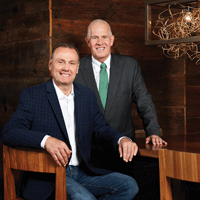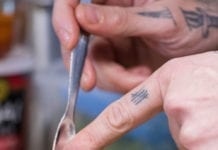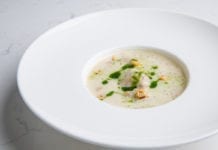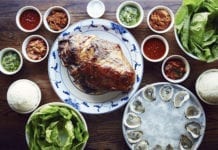With a string of hit restaurants under their belts, Peter Oliver and Michael Bonacini are quitely building an empire.
F&H: Peter, you started your career working as a real estate agent and stock broker. In 1978, you opened Oliver’s Bakery. What made you want to open a restaurant?
PO: Well, funnily enough, after university, I was on Copacabana beach in Brazil, and I started a conversation with the guy next to me who was a bus driver from Brooklyn. He had managed to organize this amazing pension package, and he said ‘isn’t it great to be lying on the beach knowing the checks just keep coming in? What you need to do is have a business where you can lie on the beach and just think about the cash register going ca-chingca-chingca-ching.’ Well my first job was in commercial real estate, and I had to be there to do the deals. So, initially that’s what I was thinking. But when I was a stock broker, we used to order in sandwiches at lunch time, and when I got the sandwiches I thought ‘you know, I could make a better sandwich than this,’ and I thought it was just a case of hard work and a commitment to quality. I was young, enthusiastic, and, at that time, the idea of it not working out wasn’t an option. Unfortunately, Michael has kept me so busy I don’t have time to go and lie on the beach.
F&H: What was the most difficult part of the transition for you?
PO: In those early days, I often went to bed at 10 p.m., and I set the alarm for 1 a.m. You can’t do it forever, but it’s amazing how hard the body can work.
F&H: What were sales like that first year at Oliver’s?
PO: They were around $200,000.
F&H: Michael, what made you want to be a chef at a young age at a time when being a chef wasn’t that interesting to a lot of people?
MB: I grew up in a small seaside town in Wales; there were two major industries — one was agriculture, the other was tourism. My parents got out of farming and into the hotel business. Their first foray was a small guest house, with six bedrooms, very seasonal. The season started in April and ended in October. Having spent a good part of my life as part of that family unit where we had to participate in running the hotel, whether it was helping out in the kitchen, changing bedsheets, cleaning wash-hand basins, emptying garbage cans — that had an influence in terms of what I was going to do and become.
The fact that my father did 99 per cent of the cooking was terrific. He was from northern Italy and had a great sense of flair and style, and, when we took trips to Italy, it was always about the food. I thought I was going to become a market gardener and be part of growing the produce — in fact, as a teenager, I used to grow lettuce. That was the bug that got me into the industry, so once I made my mind up that I wanted to become a chef I never looked back.
F&H: Michael, I’m sure you don’t perform the same hands-on work you did in the early days. How do you get your job satisfaction today?
MB: Once a chef always a chef. That’s my first love. It’s where I feel most comfortable.
I enjoy cooking at home for family and friends; I love seeing wonderful ingredients and the seasonality of food. There are ways I still get that connection to it — that little buzz and excitement. But as the company has grown, I knew I’d have to get out from behind the stoves; that I couldn’t sweat-hog it behind the stoves forever. It’s a young buck’s game.
I was delighted when the opportunity came along for me to step out from behind the stove. [But] handing over the reins was a difficult process … it’s an umbilical cord that you’re cutting. It was challenging, but you’ve got to learn to step back and let someone else take charge. And handing it over to Anthony Walsh and other members of the kitchen team has been fantastic. They’ve stood up to the challenges. So now whenever I can, I get involved, whether it’s tasting, product development, menu development, menu direction … and that’s how I get my little food buzz. Plus, I eat out a lot.
F&H: Peter, your real estate background has clearly helped you to find good locations. What’s the process now that the company is bigger? How do you sniff out those great locations?
PO: When I look at all the different restaurants and locations, the ones that have worked the best have been the ones where we haven’t gone out to look for them. Somebody has come to us and said ‘Look, we’ve got this space. Would you be interested?’ And I could point to failures of ours and of mine before I met Michael, where
I went looking for the location, and because I was hot for that location, I paid more than I should have, and it didn’t work out.
On the other hand, for example, when I went into partnership with Michael, we were offered a tremendous deal at Com-merce Court, for Jump. And, the more I said I wasn’t sure, the more the landlord said, ‘oh, well we’ll give you this,’ and they sweetened the deal. The first thing in opening a restaurant is the deal you make with the landlord. The same thing happened with Canoe. We were around at the right time; it was a recession, and, with the TD Bank, we also served their executive dining rooms. In terms of the TD Centre, we were just a little mosquito. And they were willing to give us a good deal, because they wanted somebody who would be serving the meals to the executives at the bank. And, I can go through all of them. When we did the deal with The Bay, they came to us and asked if we’d be interested. With Windermere House, it was the same thing. With TIFF it was, ‘would you answer an RFP?’ And so we did it; I’m sort of reticent now about going out and looking for a good location.
F&H: What do you think was the best location deal you inked?
PO: People often ask me which is my favourite restaurant and I can’t say, because we take real ownership — or a love creating each restaurant — and they’re all different. Certainly, our most successful restaurant that works very efficiently and effectively is Canoe. Because we serve the TD Bank’s executive dining rooms, we have two private dining rooms…. When we first started there, people said we’d never be able to get people to go back there in the evening. People will not go home, get changed, drive back downtown and come back into an office tower. It turned out that wasn’t the case. It’s unique; it’s an iconic building, with a beautiful view of the city — there are a lot of reasons to go. We always said we wanted the view to be the sixth or seventh reason that you’d go.
F&H: Your partnership has existed for 20 years. How did you get together?
PO: Well, three months before opening Jump, an employee I had offered a share of the restaurant to said he didn’t want to do it. And I wasn’t keen on doing it on my own. So I said, ‘Well, how am I going to make it even better than it would have been if he hadn’t left the deal?’ And I tried to think about who the ideal candidate would be. At that time, Centro was the hottest restaurant in Canada and Michael Bonacini was the hottest chef, so I went to him and did the old ‘I’m going to make you a deal you can’t refuse.’ It was a great opportunity for two young guys to get into business without having to put a lot of money down. Michael is the best partner I could ever have, and I’m very lucky.
F&H: Define your relationship for me.
MB: Peter is the visionary of the company; he’s the big thinker, he looks from above and decides what direction the company should be going, and nine out of 10 times, I’ll agree, so it makes it easy. I take care of the food side of things, even though I do hand a lot of it off now to our other chefs like Anthony, Jamie and Marcus, who are terrific. I get involved in the design and construction. I do my share of the PR and marketing. I get involved in the interviewing and hiring of the chefs; I look at the direction of the menus and keep things moving forward on a day-to-day basis. The relationship we have has been one where one and one equals six. It’s a phrase we coined a few years ago. It’s about the power of two coming together, and it can be an enormous, immense energy as we wanted to grow and build the organization. And it’s been fantastic. Yes, there’s the odd time where we may disagree with something, and we’ll each go our separate ways for a while, but we’ll come back.
PO: He’ll come around and see my point of view. We have a great chemistry and, in some ways, I’m shocked because it’s a bit like on a hockey line, somebody passes instinctively knowing the other person’s there. Sometimes Michael and I don’t communicate, but we know instinctively what the other person is doing. The single biggest reason our partnership has worked is that we each spend time thinking and asking ‘what does the other person want? What is the other person looking for? Where does the other person want to be?’ If I focus part of my energy on helping Michael get what he wants and he does the same thing, it’s going to work. I think that probably happens in a marriage.
F&H: With so many different restaurants, how do you balance the different requirements of the menus?
MB: We view each of our restaurants as unique concepts. Even the Café Grills, which, to use a general term, would be described as a multi-unit concept. We definitely look at how we can regionalize our menus. For example, the Café Grill in Collingwood, [Ont.] features white fish from Lake Huron, apples from local orchards in Collingwood and some of the local wine grown from the hills of Collingwood on the wine list. There’s always going be core items on the menu that will be replicated at the Café Grills, but by regionalizing it, it really helps identify culinary roots.
With the single concepts, we create a vision for the restaurant, and we stick to it. When we opened Canoe, we sat at table six, overlooking the lake one morning. It was a beautiful morning, and we were there thinking, ‘Geez, what is the concept?’ And the sun was coming up, sailboats on the lake, and we thought, ‘We should do something that represents Canada, that we’ll all be proud of.’ Make it the kind of place that a PM would want to bring a dignitary from overseas, or that I’d want to show my parents. And we spearheaded Canadian cultural cuisine, and that’s been the rock, the cornerstone of that cuisine at that particular restaurant. Jump was modern American cooking, with a little Italian influence and great North American classics, but it was a big enough canvas that it could reach out to a cultural cuisine.
F&H: Canoe was ahead of its time in terms of promoting Canadian cuisine. Today, local is very big. Do you think we have a Canadian cuisine?
MB: I do think we are well on our way to carving out what will be seen as regional, Canadian cuisine. Whether it’s East Coast, West Coast, whether it’s from Ontario, whether it’s mountain cuisine of the Rockies, from the Prairies … we’re very much on our way. When I left London, after being at The Dorchester, heaven knows English cuisine was nothing to rave about. But Anton Mossiman took on the charge of wanting to define what great British cuisine was, and today it’s one of the world leaders in culinary cuisine. Canada is in the same sort of groove; we’re on the same road. And it’s relentless, the number of new and innovative growers, producers, purveyors — how everyone is latching on to foraged foods, locally harvested, sustainable, digging back into recipes from their heritage, their families as they were immigrants coming over, cooking dishes that were the foundation of their background.
PO: Food is holy, there’s something spiritual about it and more people are appreciating that. This movement is inevitable.
F&H: You’ve grown the catering part of your business incredibly over the last few years. What made you pursue this segment?
PO: It was just an appreciation of the opportunity. We always knew we had private dining rooms that organizations wanted to use for events and that there was a market for weddings. Understanding that demand, we made the determination that we wanted to become very good at events. The bigger you get, the better you get. We now have 22 people that are event coordinators, and all they do is book events. Last year we did 9,000 events. Some of those are smaller breakfasts and the number goes up to dinners of 500 people at the Arcadian Court. We’ve just got an incredible events team. They are young and bright and enthusiastic, so when someone phones and says they’d like to book an event for 40 people at Canoe, we can tell through the computer programs immediately that Canoe might be booked, but we might have an opportunity at this restaurant, that restaurant, or this event space. We built an event-planning studio, and it’s quite professional. There’s a big opportunity in events to take it to another level. I’m very proud of our events team.
F&H: Out of your total sales mix, what percentage comes from catering?
PO: I can’t give you the exact percentage, but my guess would be that our private dining in the restaurants, together with events, would be one third [of sales]. And, I know that people running events are determined they will overtake the restaurant sales.
F&H: Tell us about your newest restaurant, Bannock.
PO: Here again, out of the blue, we got a call from somebody at The Bay asking if we’d be interested in taking over their foodservice at the Bay and Queen location. And, if we did a good job, they said we’d have an opportunity with The Bay stores across the country. That sort of thing is very flattering, but then you’ve got to say to yourself ‘do we have the infrastructure to do it?’ We were very keen on the location at the corner of Queen and Bay where Bannock is. And we were keen to put another Canadian comfort food concept on that corner, which sort of ties in with The Hudson’s Bay Company, because it was the earlier explorers who developed The Bay and their staple was Bannock.
But we also knew we needed the financial resources and the across-the-country reach of a company like Compass, who is our partner. So for us to be able to partner with them was a real honour, and to partner with The Bay was also an honour. In any partnership, the key to success is working so hard that the other guy says ‘the best thing we ever did was getting into business with Oliver and Bonacini.’
Running restaurants and events is our shtick. We spend all our time thinking about how we can be better at that. And The Bay, I think, is very happy. Bonnie Brooks is doing an amazing job at repositioning The Bay. They’re keen for us to go into many other flagship stores, and we are pondering that because it’s one thing to have everything in the GTA, or just outside, but to go four hours to Calgary is another story. We will never expand unless our core business is getting better — not staying the same, but getting better.
F&H: What’s the next goal? How big do you want to get?
PO: We’re not motivated by growth. We want to be the best people’s first choice as an employer. And so, as we get great people joining the company, we’ve got to provide them with challenges. If anything, our growth will be predicated on providing opportunities for superstars who are in our company, because if we can’t provide them those opportunities they’re going to go somewhere else.
If somebody leaves, I take it personally. And people are going to leave because they get offered great opportunities elsewhere, but we are a family and we care about each other. We care about some young guy that wants, and is ready, for a new challenge, and we say to that person ‘would you consider going to Calgary for two years to help us?’ If we know that person has the O&B values and wants to prove themselves, I have no problem taking that leap. Very seldom have we been wrong. Sometimes we promote people before they’re ready. That has actually been a good policy because it hasn’t happened very often that the person hasn’t risen to the occasion. I like to see a little bit of fear on a young person. The worry of ‘oh my goodness, how am I going to do this? They go home and think about life and think ‘I can do it!’ and that’s a very rewarding part of the business for me.
F&H: How have you been able to inculcate such a strong corporate culture in your company?
PO: Leadership is a lifelong quest. First, you need a vision. You need to communicate it either to each individual restaurant or to the company as a whole. That’s important. Doing the orientation for every single employee — and we have about 1,200 right now — is the best part of my job. I come away so motivated that we have these incredibly bright people who have joined the company. They appreciate that the leadership at O&B is itself engaged. If they thought I was lying on a beach in Copacabana, it would not be the same as me doing the orientation. They see that Michael is incredibly passionate about the food, very knowledgeable about it, he’s not afraid to roll up his sleeves and clean up drains. The fact that the owner of the company welcomes each individual employee to the company personally is important.
F&H: Do you both interview everybody? When you hire do you look at cross training and development or specific for that unit at that time?
MB: We don’t interview every employee who comes on board. We certainly interview the senior management. I certainly like to interview and be part of the interviewing process when we’re hiring a new chef or a senior sous chef or a junior sous chef. Peter enjoys interviewing when it’s a general manager or a new member of the executive team.
Having a strong culture means hiring people is going to be an ongoing challenge in terms of finding them and ensuring they are a great fit. But with this strong sense of culture, and everyone reading from that same song sheet, it’s almost like an implant in a body, and if a body says it’s not the right piece, it gets rejected. And that’s what does happen. It’s an ongoing challenge to find the right individuals to grow the company. It’s part of the process that needs to be given the appropriate amount of time to ensure they are the right fit for us to continue to grow. Growth alone is not the priority that O&B is focused on. We have a portfolio of restaurants that spans from very casual, grab-and-go eating, take-out to fine-dining. We’ve taken on board new entrepreneurs who share the same values we have and are a terrific fit and we want to continue to look at those opportunities. That is going to be our number-1 challenge — finding the human resource element to make that happen.
F&H: Do you offer profit sharing?
PO: We have a framework for a stock option plan for our executives. People’s compensation is very important, and we always want to be at the top end. However, the other parts of it where people are learning, growing — and feeling they are a part of creating something unique — is just as important. When I first started, I was so vain I thought I could do everybody’s job better than they could. Life has taught me there is somebody who can do every single part of the work better than I can. And sometimes I’m embarrassed at how long it’s taken me to realize certain things.
We want every employee who comes to work every day to have all of their brain cells switched on. We want to be an intelligent company. We want the discourse, or the way in which we talk to each other at work, to be intelligent. We want to hire people who want to be part of an intelligent company because intelligence is increasingly ruling the world. I believe there’s two kinds of people in this world — live wires and bozos. A company of bozos is just not going to cut it. We want to be a company of live wires. All of our guys are live wires. They have that inner drive, that inner quest to do a good job. To watch that come together, where people feed off each other, is very motivating.
Keep Reading
The O&B Leaders Take Centre Stage
Foodservice Operators Up the Ante With New, Gourmet Soup-and-Sandwich Choices
From Sourcing to Purchasing, How Is Seafood Measuring Up?



